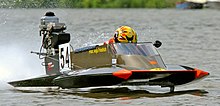Racing boat
Racing boats are watercraft whose construction is primarily geared towards high speed and competitiveness in sporty boat races.
history
The term racing boat appears roughly at the same time as the term racing car, i.e. roughly with the development of the internal combustion engine around 1900. It was only this that enabled the construction of small boats with powerful engines, which are suitable for racing e.g. B. suitable on circuits around buoys .
There were races on the water centuries before. B. between sailing ships and Mississippi steamers or with passenger ships the competition for the Blue Ribbon . The record hunt for the highest speed achieved with a racing boat, analogous to that with automobiles, was pursued with great effort in the first half of the 20th century, numerous fatal accidents with great public interest.
Modern racing boats
Today there are a multitude of different racing boat classes. The use of helicopters and airplanes in the report on boat races made offshore racing boats such as catamarans and monopostos particularly popular. Most motor boats today are on plane , which means that the boat only uses the water for propulsion and steering , not for displacement through displacement . The aim of a "glider" is therefore always to use fluid dynamics to ensure that the contact surface between the boat and the water is as small as possible.
The fastest racing boats are driven in the US these days and reach speeds of over 300 km / h. The drive concepts range from two and four-stroke engines to gas turbines . Due to the high speeds, the boats can only be driven on large, extensive inland waters .
basic forms
catamaran
The catamaran has two hulls that are connected to a rigid floor. Compared to the proprider, the catamaran is much more stable. The two boat hulls act like rails. This means that curves can be driven much tighter. The driver sits in the boat and accelerates with his foot.
Three point
The three-point is a very flat racing boat. The bottom of the boat has a "paw" on the left and right. At high speed, the boat only rests on the water with both paw ends and the end of the boat, hence the name “three-point”. In the case of "small" three-point vehicles, which are usually boats with outboards up to 500 cm³, the driver kneels in the boat, steers it with one hand and operates the throttle with the other. For "large" three-point marks, such as For example, in the inboard class up to 1000 cm³, popular in Germany, or the American Unlimited Hydroplanes , the driver sits in the boat and has "normal" foot throttle.
Proprider
At first glance, the proprider does not differ from the three-point vehicle. However, the boat is a little longer and is driven lying on its stomach. During ideal speed, only the propeller is in contact with the water. The paws are only used to support the trunk occasionally.
Triangular file
The boats have a V-shaped hull like a touring boat. They are also called triangular files. With the appropriate setting of the motor and propeller, this type of boat also lifts almost completely out of the water at full speed. The driver sits upright in the boat. In Germany this type of boat is driven with 550 cm³ outboard motors (class T-550).
General
The first three forms are designed in such a way that, thanks to their special construction, they create an air cushion that minimizes the immersion depth. The outermost design is the proprider, in which only the screw is immersed at full speed, which is why the speed record for boats with outboard motors - 284.14 km / h - was achieved with this boat shape. What all racing boat types have in common is that the less water they touch, the faster they are. So they don't have a V-shaped bottom like most touring boats, but a flat bottom. All types generate few waves and have high-speed rotating surface propellers .



